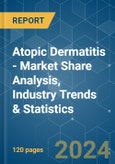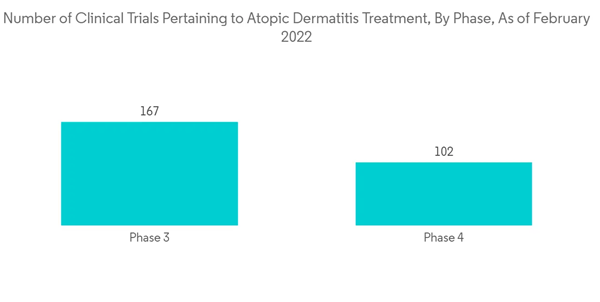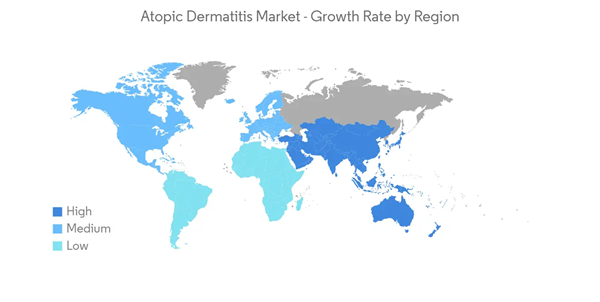The Atopic Dermatitis Market size is estimated at USD 10.06 billion in 2024, and is expected to reach USD 14.23 billion by 2029, growing at a CAGR of 7.18% during the forecast period (2024-2029).
This product will be delivered within 2 business days.
Key Highlights
- The COVID-19 pandemic significantly impacted the atopic dermatitis market. As per an NCBI article published in March 2022, atopic dermatitis is associated with an increased risk of COVID-19 infection. Also, several initiatives were introduced to manage COVID-19 patients suffering from atopic dermatitis.
- For instance, as per a June 2020 update, the SECURE-AD Patient survey is designed to help understand how the coronavirus pandemic (COVID-19) affects people with atopic dermatitis (also called atopic eczema). This survey encouraged the patient population with atopic dermatitis worldwide to participate and report their experience with COVID-19 infection. Such studies gathering the complications in patients with atopic dermatitis infected with COVID-19 provided the understanding and tolerability for various treatments of atopic dermatitis, thereby impacting the market growth. Thus, the pandemic significantly impacted the market's growth during the COVID peak stages. However, after the relaxation of strict regulations on patient consultations at healthcare centers, the current market scenario is expected to drive growth during the forecast period.
- The significant factors fueling the market's growth are the increasing burden of allergic reactions, an important role played by food allergy, and increasing environmental pollution. The growing burden of allergic reactions, with a significant role in food allergies, is driving the market's growth. For instance, Food Allergy Research and Education (FARA) report in 2020 estimated that 32 million United States residents have food allergies, including 5.6 million children under age 18. About 40% of children with food allergies are allergic to more than one food.
- Additionally, according to the Australian Society of Clinical Immunology and Allergy (ASCIA) update in May 2021, food allergy occurs in around 10% of infants, 4-8% of children, and about 2% of adults in Australia and New Zealand. Moreover, according to an article published in Nutrition Today Journal in February 2020, food allergy is a significant public health issue. It affects an estimated 3% to 10% of adults and 8% of children worldwide.
- Likewise, accoring to a National Center for Biotechnology Information (NCBI) article in June 2020, infants with temporary skin barrier disruption and persistent atopic dermatitis are particularly at risk of developing food allergies. Among them, severe cases of atopic dermatitis with positive symptoms were observed in one-third of patients in an oral food challenge. As per the same study, many children with atopic dermatitis exhibit asymptomatic sensitization to foods. As food allergies result in atopic dermatitis, the increasing burden of allergic reactions across the globe is anticipated to increase the demand for treating atopic dermatitis worldwide, propelling the market growth.
- Additionally, the regulatory authorities approvals are propelling the market's growth. For instance, in December 2021, LEO Pharma Inc. reported that the United States Food and Drug Administration (USFDA) approved Adbry (tralokinumab-Adam) for treating moderate-to-severe atopic dermatitis in adults 18 years or older.
- Thus, the market is expected to show growth over the forecast period due to the abovementioned factors, such as the increasing burden of allergic reactions and product approvals. However, severe adverse effects of certain therapeutic drugs significantly hinder the market's growth.
Atopic Dermatitis Market Trends
Corticosteroids Segment Dominated the Atopic Dermatitis Market Over the Forecast Period
- By drug class, the corticosteroid segment is anticipated to witness significant growth. Corticosteroids are referred to as cortisone-like medicines that are used as pain relief medications for inflammation in the body. These drugs reduce itching, swelling, allergic reactions, and redness. The major factors fueling the segment's growth are the increasing innovations leading to the advent of counterfeit medicines and alternative drugs and strategic initiatives undertaken by the market players.
- According to the National Eczema Association (NEA) data published in 2022, corticosteroids are the most commonly prescribed medications for all eczema, reducing inflammation and itching. Corticosteroids have been used for over 60 years as topical medicines to treat many inflammatory skin conditions, including eczema. Such efficiency of the corticosteroids is expected to drive the growth of the studied segment over the forecast period.
- Furthermore, Lilly's lebrikizumab demonstrated significant skin improvement and itch relief when combined with topical corticosteroids in people with atopic dermatitis in the third Phase 3 study. Lebrikizumab, an IL-13 inhibitor, significantly improved disease severity when combined with topical corticosteroids in people with moderate-to-severe atopic dermatitis.
- Thus, the atopic dermatitis market is anticipated to witness significant growth during the forecast period due to the increasing demand, the efficiency of corticosteroids, and increasing product developments.
North America is Expected to Witness a Significant Growth Over the Forecast Period
- Within North America, the United States is expected to hold a significant share of the market. The major factors fueling the market's growth are the increasing prevalence of atopic dermatitis, high treatment awareness among the patient population across the United States, well-established healthcare infrastructure, and early adoption of novel medications.
- For instance, according to a Journal of the American Medical Association (JAMA) article published in June 2022, nearly 45% of survey participants reported having moderate atopic dermatitis, while 28% of the survey participants had severe atopic dermatitis in 2021. In addition, better reimbursement policies, increasing business partnerships of pharmaceutical companies with contract research organizations in emerging markets, and product developments are boosting the market's growth.
- For instance, in February 2022, Evelo Biosciences, Inc., reported that the first patient had been dosed in EDP1815-207, its Phase 2 randomized clinical trial of EDP1815 for the treatment of patients with mild, moderate, and severe atopic dermatitis. Also, in February 2021, the United States Food and Drug Administration (USFDA) accepted the Priority Review of New Drug Application (NDA) for Ruxolitinib Cream by Incyte Corporation, a selective JAK1/JAK2 inhibitor designed for topical application as a treatment for atopic dermatitis, a type of eczema.
- Moreover, the increasing investments in atopic dermatitis are expected to contribute to this region's growth. For instance, according to a National Health Institutes (NIH) article published in June 2021, the estimated funding for atopic dermatitis research was USD 46 million in 2021 and USD 44 million in 2022.
- Thus, the market is expected to witness significant growth during the forecast period due to the increasing prevalence of atopic dermatitis, high treatment awareness among the patient population, and increasing operational activities for atopic dermatitis.
Atopic Dermatitis Industry Overview
The atopic dermatitis market is moderately competitive market with major players dominating the market. The competitive landscape includes an analysis of a few international as well as local companies which hold market shares and are well known. The presence of major market players, such as Pfizer Inc., Novartis International AG, Allergan PLC, and Abbvie Inc., is increasing the overall competitive rivalry of the market studied.Additional Benefits:
- The market estimate (ME) sheet in Excel format
- 3 months of analyst support
This product will be delivered within 2 business days.
Table of Contents
1 INTRODUCTION
4 MARKET DYNAMICS
5 MARKET SEGMENTATION (Market Size by Value - USD million)
6 COMPETITIVE LANDSCAPE
Companies Mentioned (Partial List)
A selection of companies mentioned in this report includes, but is not limited to:
- Abbvie Inc.
- Allergan PLC
- Bausch Health Companies Inc.
- GlaxoSmithKline PLC
- Nestle SA
- Pfizer Inc.
- Regenron Pharmaceutical Inc.
- Evelo Biosciences
- Cara Therapeutics
- Bristol-Myers Squibb Company
- Sanofi S.A.
- LEO Pharma
Methodology

LOADING...










